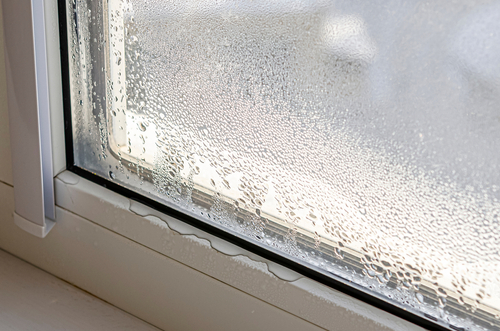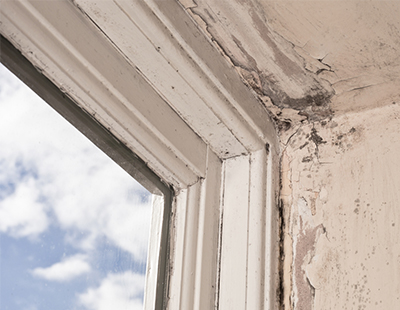
The sudden drop in temperature as we move into Autumn isn’t just a shock to the system, it can also lead to unwanted condensation starting to appear around many people’s windows.
Condensation is essentially the water beads that form when hot moist air meets a cool surface. Whilst it’s quite common and doesn't necessarily mean there's a problem with your windows, if it is not maintained efficiently then it can develop into dangerous mould which is linked to health conditions such as asthma, eczema and Bronchitis.
That’s why it's important to keep condensation at bay before it worsens and causes damage to your home and health.
The main reason that condensation gathers is due to factors inside your home, such as the ventilation and how many people live in the property, so there’s plenty of ways to try and prevent it.
However small it may seem, it’s a problem that shouldn’t be ignored. If moulds, which contain allergens and toxic substances, begin to form in your home it has been proven to cause serious problems for people with existing health conditions such as eczema, asthma, and those with a weakened immune system.
Ventilation - If your home is suffering from condensation, damp or mould, the best thing you can do is to try and improve the ventilation inside. Try to regularly open windows to allow air to move freely and let moist air escape from the property. Ventilation systems such as extractor fans can also massively help to reduce the condensation in your homes.
Humidity - Reducing how much moisture is in the air can have a huge impact on tackling condensation dampness. Little changes such as having your tumble dryer vented outside and hanging washing in airy spaces, instead of drying it inside warm rooms, can really help to keep the mould at bay.
Heating - It helps to try and keep the temperature inside the property reasonably consistent and to regularly heat your home to a warm temperature. This stops there being a stark contrast in temperature that allows condensation to develop. Having a warm and well-maintained home is an unlikely environment for mould growth.
Insulation - Making sure your home is better insulated can also really help when tackling condensation and dampness. Double glazing, wall insulation and draught-proofing will help to reduce the amount of heat that is lost from your home. Having well installed, energy-efficient windows will help to keep the property's temperature high which can have a massive impact on condensation and mould growth. Our windows here at Safestyle are all A-rated for efficiency and recommended by the Energy Savings Trust, as they are specifically designed to harvest as much free energy into your home as possible.
For existing damage: To effectively get rid of mould and condensation that’s already settled on your windows, make sure to carefully clean the area with a mould-removing product or solution that kills the bacteria, such as 1 part bleach to 10 parts water.
* Adam Pawson is the property expert at window supplier Safestyle *
Want to comment on this story? Our focus is on providing a platform for you to share your insights and views and we welcome contributions.
If any post is considered to victimise, harass, degrade or intimidate an individual or group of individuals, then the post may be deleted and the individual immediately banned from posting in future.
Please help us by reporting comments you consider to be unduly offensive so we can review and take action if necessary. Thank you.





.jpg)








.jpg)






.png)





Join the conversation
Jump to latest comment and add your reply
Isn’t it ironic that surveyors and professional contractors all give the same reasons for condensation and mould but the Governments north and south tell landlords they can no longer keep blaming condensation on tenants lifestyle. It’s staring them in the face!
Yep. One of my tenants asked me about a little mould and condensation and how to avoid it. 'Open the Windows!' she responded with horror.
Go figure
Yes I told a tenant that last year, she became very abusive and flatly refused to do so, so I'm expecting more condensation and mould this winter
There is an answer for those unusual tenants who wish to keep their windows closed during winter months to retain heat and for security & safety:
We've had our electrician install Nuaire Drimaster 'Heat' Positive Input Ventilation (PIV) units in all of our rental houses and flats. Our Building Manager has a rolling calendar reminder to change the filters every 3 years (Nuaire states the filters last 5 years but from our testing this is incorrect).
We have fitted locked covers over the ON/OFF switches so our tenants cannot accidently turn off the PIV units. These switch covers are from a great company called Security Safety Products. Tenants are now delighted and their washing and bathroom towels dry within hours, no condensation on the windows and no damp/mould in the corners of rooms/backs of wardrobes.
Simple, low-cost PIV mechanical ventilation is the fit-and-forget solution to damp and mould. It's not rocket science.
Martin - what do you do for a living - do you have a vested interest - I find it interesting you are not more forthcoming on the question - I suspect most of us on this forum know you are simply selling something
Martin,
These units consume a lot of electricity! They are on 24/7 ,that adds up !
Good question, Edwin. My wife monitored it in flat that we have and it cost £40 pa in electricity to run the Nuaire PIV unit. We felt that was proportionate for the multiple benefits that mechanical ventilation delivers to both the tenant and our building.
worth 40 pounds p yr if it does the job
Stop drying clothes inside, the other day when I visited 2 front rooms with condensation running down. Wet clothes straight out of the washing machine on coat hangers all along the curtain rails with windows shut tight ridiculous.
Amazingly there is no mould because only use anti mould paint / Crown extreme mould inhibiting, extreme fungicidal barrier defence & stain resistance £50. for 5 litres + £10. stupid VAT, not a 10 litres tub for £18. incl’ VAT from local DIY Store.
My concern is that even if there is no mould, the plaster will rot due to the condensation dampness.
I've written to mine asking them to dry the clothes outside.
Exactly, our 1st rental was our home for 18 years, tenant's of certain persuasion hate this fact, as we NEVER once suffered condensation, not onc. Lol, our previous tenants were utterly lazy, early 20's who'd rather by on PS4 & social media etc. With all their washing from day 1 dried indoors, sadly, didn't have the capacity to understand how to prevent, or even mitigate, and will never change their habits, as far to time consuming having to take wet washing and hang up on the line provided in the lovely back garden, literally meters away, but nope, no chance.
The last cp12, we instructed how gas man would operate, & x y z needs to be cleared, a minute after gas man arrivied he phoned stating he's not prepared to work under such conditions, absolutely disgusting the amount of washing everywhere, including underwear piled high on rad they complained about as not giving out much heat, it won't with it always smoothered, doh!
So, how can we honestly deal with tenants like this, in our case it was 100% bad habits, they cannot argue it's etc properties fault.
Probably not because of little penetration but will ruin your double/ tribble glazing unit’s.
Agree dry the clothes outside and open the windows, all Summer passed by without doing either. They live in unhealthy smelly air and conditions, anyway I have told them I am not continuing with the let while I still can due to other factors like subletting, rent arrears and changing locks that was done for compliance etc etc.
The Renter’s Reform Bill must be to protect those, certainly not for any good purpose.
Some Borough’s now offer Shipping Containers Villages Accommodation as alternative to housing shortage they created and the driving out of Private landlords, I am sure you’ll have your own take on this.
Matin Gibbons, your grammar is poor and so is your maths. PIV systems work by preheating air blown into a building and relying on leakage for ventilation. Therefore leakage needs to be in room affected by condensation. Current max rate of electricty is approx 34 p per kilowatt. So say Approx £1 per 3 kilowatts, £3 perday for 0.4 kw heater.. Needs to be heating about 70 percent of the year, because input air is ambient temperature, approx 250 days per year. Thats about £750 per year, plus of course the ducting and installation costs. Of course the tenant needs to leave it switched on, and in the still of night these fans can be noisy. Obviously depends on electricity tariff.
Please login to comment